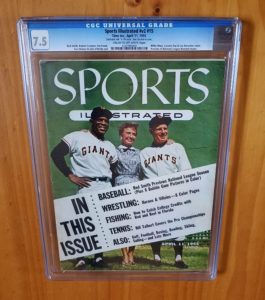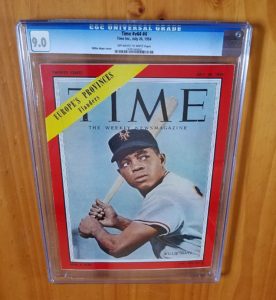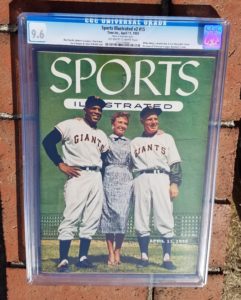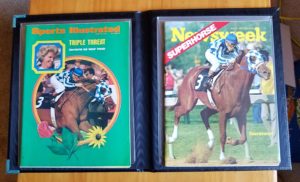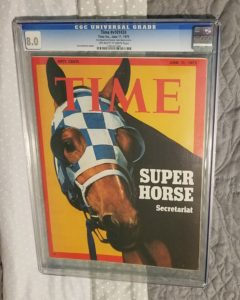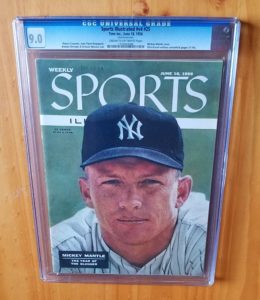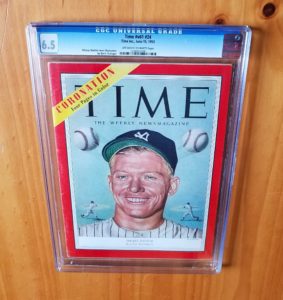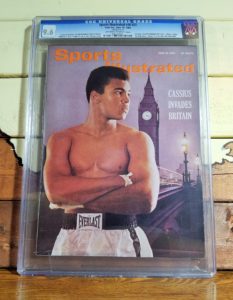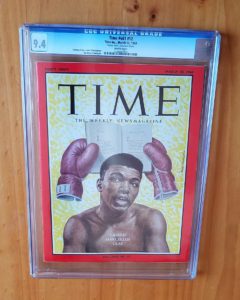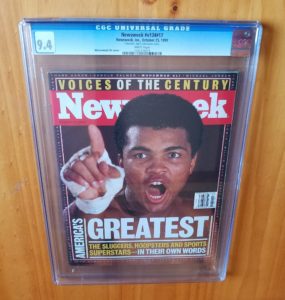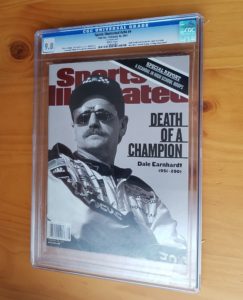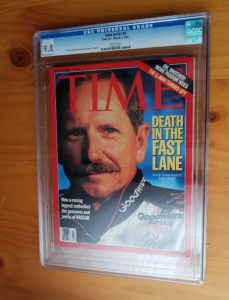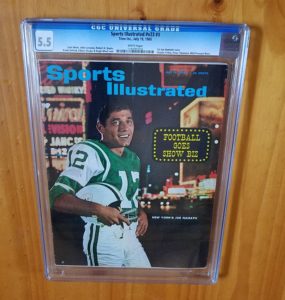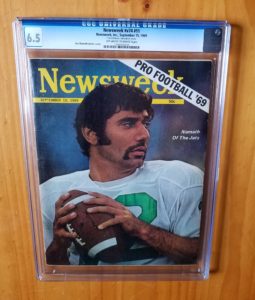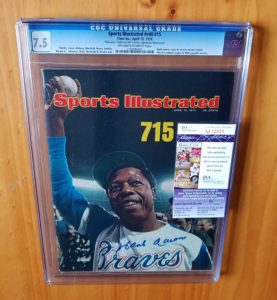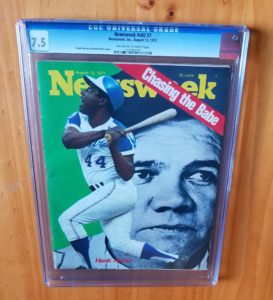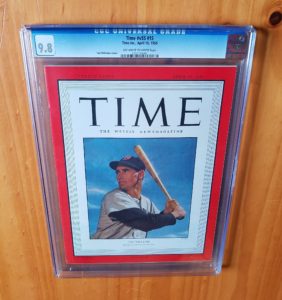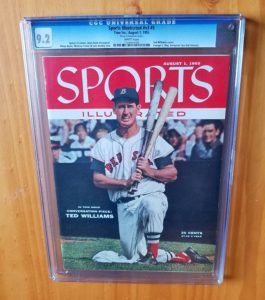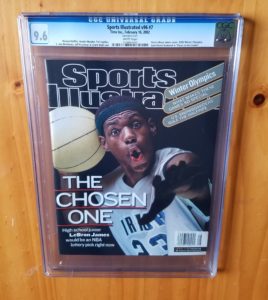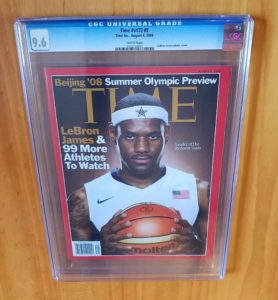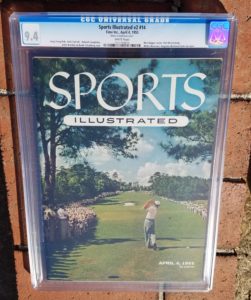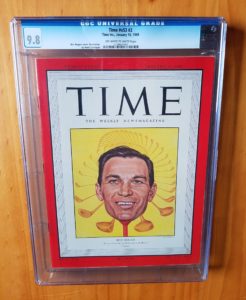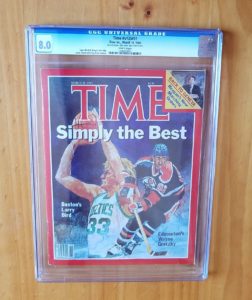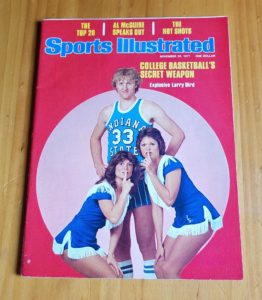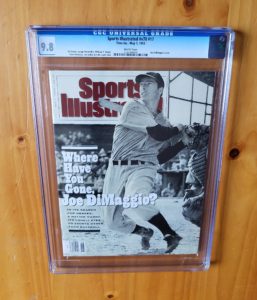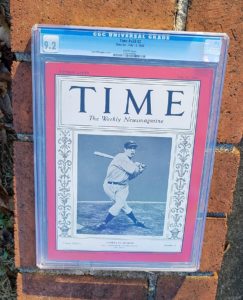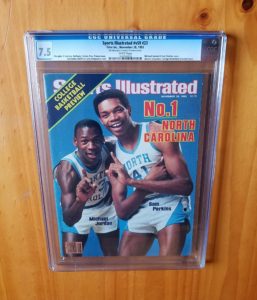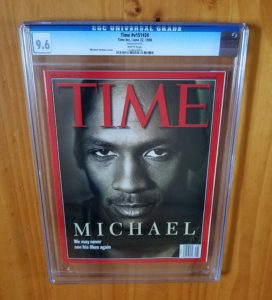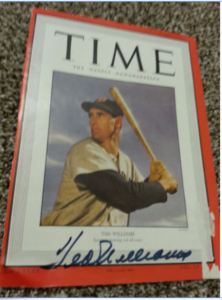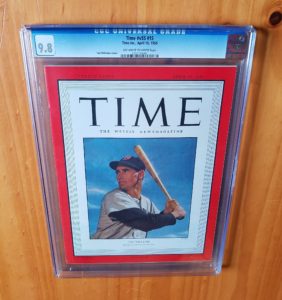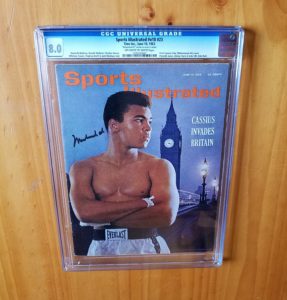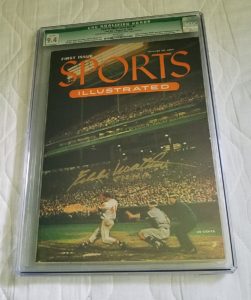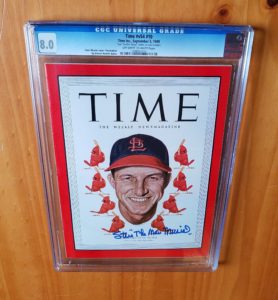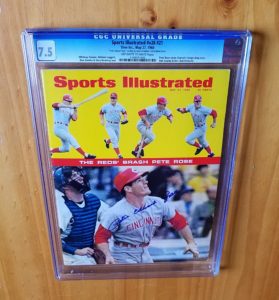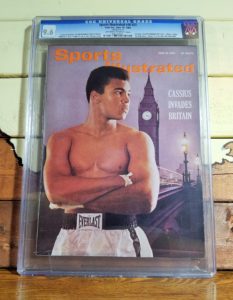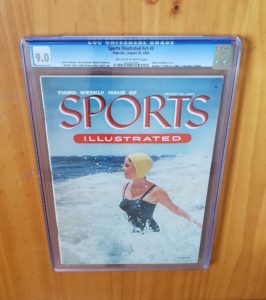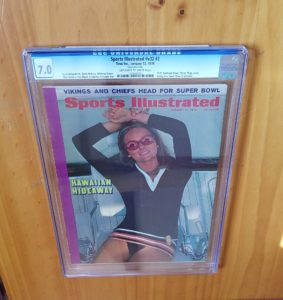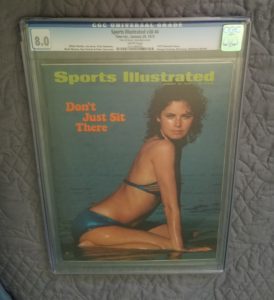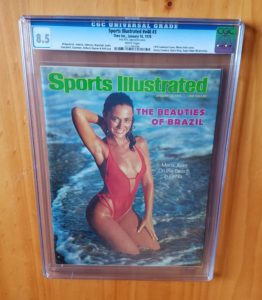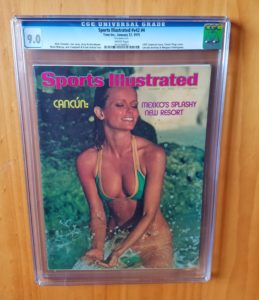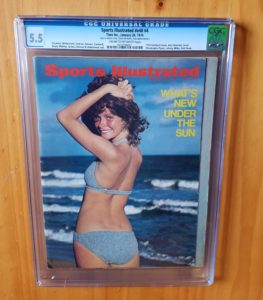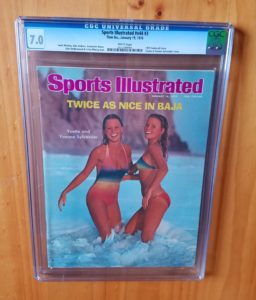Welcome to my Sports Illustrated/TIME magazine blog – Your collector’s guide to the latest hobby updates and insight into what’s trending now.
Sports Illustrated Blog #19 – Sports Illustrated’s First Graded Price Guide.
Today is a big day in SI collecting. With this blog, I am introducing the first CGC SI graded price guide. Every collectable had to start somewhere, from cards, to comics, to raw magazines and now to graded magazines. The first caveat I will make is yes, I know, I’m a seller of graded magazines which is a conflict. My answer to that is who better than me. I have firsthand knowledge of the selling points of most of the higher valued items in the list. I know where most of the 9.8’s, 9.6’s, and 9.4’s are because, for the most part, I bought the raw magazine, had them graded and sold them personally. And finally, in an effort to back up what I print, I am definitely interested in listening to any (wholesale) offer of the retail selling price listed in my guide.
Let’s also treat this list as a guide, a beginning – something to build on. In my pursuit of High Grade Newsstand SI’s, I often sense the indecision and sometimes fear that a seller experiences when they have no guide by which to base their selling price. With this guide, the seller will at least be informed as to what I have experienced. He/She will have a starting point on which to base negotiations. Valuing graded collectables is much easier than non-graded simply because the grade itself (assigned by a recognized grader – CGC) is a form of value. In the same way that we recognize a dollar bill to have a value, so do we recognize 9.8, 9.6, or 9.4.
First glance at some of the guide values will surprise some readers so I sent a preliminary version of this guide to several of my SI buyer contacts to gain a perspective from their angle. Without exception, each contact expressed a form of excitement regarding where the hobby was headed, recent auction results and universal support for the guide itself and the content.
Evolving guide prices will be always be driven by cover popularity and the difficulty in finding a high grade newsstand SI. I hope this effort will result in more magazines being graded so the census numbers grow and in turn become more statically valid. Small and large collectors and investors will experience firsthand the probability of finding vintage (pre-1980) magazines above the grade of CGC 7.0 not to mention CGC 9.0! And we all will begin to better understand the price points on the highest of CGC graded issues.
I predict that some SI issues will never achieve a 9.8 while others will top the charts in multiple cases. I am the largest purchaser of CGC graded SI’s and have never received a 9.9 or 10.0 which gives you some idea of your chances for one of these grades. It seems these grades have been reserved only for comics.
Note that I have included a value designation of “Open” in a number of places. I have chosen to use this designation because no magazine of this grade has ever been transacted and the price will be determined at the first auction. Also, top grade values are tougher to predict because when multiple bidders are vying for the highest grade item with a POP 1, no one knows the summit.
So here you have it. Feel free to write me with any questions or opinions. Any experiences you have had are openly welcomed as well.
| Ranking – Top 100 Hardest to Find Sports Illustrated Issues | ||||||||||
|
Rank |
Year | Newsstand Cover | CGC Grade 9.8 | CGC Grade 9.6 | CGC Grade 9.4 | CGC Grade 9.2 | CGC Grade 9.0 | CGC Grade 8.0 |
CGC Grade 7.0 |
|
|
1 |
1961 | Roger Maris | Open | Open | Open | Open | $5,000 | $2,500 | $1,000 | |
|
2 |
1956 |
Mickey Mantle (all pages) | Open | $25,000 | $10,000 | $7,500 | $5,000 | $2,500 |
$1,000 |
|
|
3 |
1959 |
Johnny Unitas |
Open | Open | Open | Open | $5,000 | $3,000 | $1,500 | |
|
4 |
1967 | Roberto Clemente | Open | Open | Open | Open | $5,000 | $2,500 |
$1,000 |
|
| 5 | 1969 | Reggie Jackson | Open | Open | Open | Open | $5,000 | $2,000 | $1,000 | |
|
6 |
1961 |
Fran Tarkenton |
Open | Open | $5,000 | $2,500 | $1,500 | $1,000 | $500 | |
|
7 |
1968 | Pete Rose | Open | Open | $5,000 | $3,000 | $2,000 | $1,000 | $500 | |
|
8 |
1969 | Hank Aaron | Open | Open | Open | Open | $10,000 | $2,000 | $1,000 | |
| 9 | 1963 | Cassuis Clay | Open | $25,000 | $10,000 | $5,000 | $2,500 | $1,500 |
$1,000 |
|
| 10 | 1960 | Jim Brown | Open | Open | Open | Open | $5,000 | $3,000 |
$1,500 |
|
|
11 |
1962 |
Mickey Mantle | Open | Open | Open | Open | $2,500 | $1,000 | $500 | |
|
12 |
1961 | Bart Starr | Open | Open | Open | Open | $5,000 | $2,000 | $1,000 | |
| 13 | 1955 | Ted Williams | $15,000 | $7,500 | $5,000 | $2,500 | $1,500 | $1,000 | $500 | |
| 14 | 1964 | Swimsuit | Open | Open | $5,000 | $2,500 | $2,000 | $1,000 |
$500 |
|
| 15 | 1965 | Joe Namath | Open | Open | Open | Open | $5,000 | $2,500 |
$1,000 |
|
|
16 |
1965 | Swimsuits (1965-1969) | Open | Open | $10,000 | $5,000 | $3,000 | $2,000 | $1,000 | |
|
17 |
1974 | Hank Aaron 715 | $10,000 | $4,000 | $3,000 | $2,000 | $1,000 | $500 | $250 | |
| 18 | 1970 | Swimsuit | Open | $10,000 | $5,000 | $4,000 | $3,000 | $2,000 | $1,000 | |
| 19 | 1960 | Jack Nicklaus | Open | Open | Open | Open | $5,000 | $2,500 | $1,000 | |
|
20 |
1971 | Swimsuits (1970-1979) | Open | $5,000 | $4,000 | $3,000 | $2,000 | $1,000 | $500 | |
| 21 | 2002 | Tom Brady The Natural | $3,000 | $1,000 | $400 | $250 | $100 | Common | Common | |
|
22 |
1954 | Issue #2 | Open | $10,000 | $5,000 | $2,500 | $1,500 | $1,000 | $500 | |
| 23 | 1956 | Warren Spahn | Open | Open | Open | Open | $1,000 | $500 |
$250 |
|
|
24 |
1981 | Wayne Gretzky | $25,000 | $10,000 | $5,000 | $2,500 | $1,000 | $500 | $250 | |
| 25 | 1977 | Larry Bird | Open | $10,000 | $5,000 | $2,500 | $1,000 | $500 |
$250 |
|
|
26 |
1970 | Steve Prefontaine | Open | Open | Open | $2,000 | $1,000 | $750 | $500 | |
| 27 | 1955 | Yogi Berra | Open | $2,500 | $1,500 | $1,000 | $750 | $500 |
$250 |
|
|
28 |
1980 | Olympic Hockey | Open | $5,000 | $2,500 | $1,500 | $1,000 | $500 | $250 | |
| 29 | 2002 | Tom Brady Amazing | $2,500 | $1,000 | $500 | $250 | $100 | Common | Common | |
|
30 |
1955 | Al Rosen | Open | Open | $3,000 | $1,500 | $1,000 | $500 | $250 | |
| 31 | 1956 | AllStar Game | Open | Open | Open | $3,000 | $1,000 | $500 | $250 | |
|
32 |
1955 | Willie Mays | $25,000 | $10,000 | $5,000 | $2,500 | $1,000 | $500 | $250 | |
| 33 | 1983 | Michael Jordan | Open | $25,000 | $10,000 | $5,000 | $2,500 | $1,000 |
$500 |
|
|
34 |
1975 | Ali Frazier | Open | $5,000 | $3,000 | $2,000 | $1,000 | $500 | $250 | |
| 35 | 1974 | Ali Foreman | Open | $5,000 | $3,000 | $2,000 | $1,000 | $500 |
$250 |
|
|
36 |
1971 | Ali Frazier | Open | $5,000 | $3,000 | $2,000 | $1,000 | $500 | $250 | |
| 37 | 1955 | Hogan | Open | $5,000 | $2,500 | $1,500 | $1,000 | $500 |
$250 |
|
|
38 |
1956 | Mantle WS | Open | Open | Open | Open | $2,500 | $1,000 | $500 | |
| 39 | 1996 | Derek Jeter | $2,500 | $1,000 | $500 | $250 | Common | Common |
Common |
|
|
40 |
1962 | Tarkenton | Open | Open | $5,000 | $2,500 | $1,000 | $500 | $250 | |
|
41 |
1967 | Yaz | Open | Open | Open | Open | $2,500 | $1,000 | $500 | |
| 42 | 1957 | Mantle | Open | Open | Open | Open | $1,000 | $500 |
$250 |
|
|
43 |
1965 | swimsuit | Open | Open | $10,000 | $5,000 | $2,500 | $1,000 | $500 | |
| 44 | 1967 | Orr | Open | Open | Open | $5,000 | $2,500 | $1,000 |
$500 |
|
|
45 |
1965 | Oliva | Open | Open | Open | Open | $1,500 | $1,000 | $500 | |
| 46 | 1962 | Gifford | Open | Open | Open | $1,500 | $1,000 | $500 |
$250 |
|
|
47 |
1973 | Secretariat | $25,000 | $10,000 | $5,000 | $2,500 | $1,000 | $500 | $250 | |
| 48 | 1970 | Butkus | Open | Open | Open | Open | $1,000 | $500 |
$250 |
|
|
49 |
1959 | Mays | Open | Open | Open | Open | $1,000 | $500 | $250 | |
| 50 | 1962 | Mays | Open | Open | Open | Open | $1,000 | $500 |
$250 |
|
|
51 |
1976 | Brett | Open | Open | Open | $2,000 | $1,000 | $500 |
$250 |
|
| 52 | 1976 | Schmidt | Open | Open | Open | $2,000 | $1,000 | $500 | $250 | |
I hope you are enjoying the reads on the history of TIME and SI magazines as well as an insight into relevant magazine collecting.
Great collecting to you and best fortunes with Sports Illustrated/TIME!

